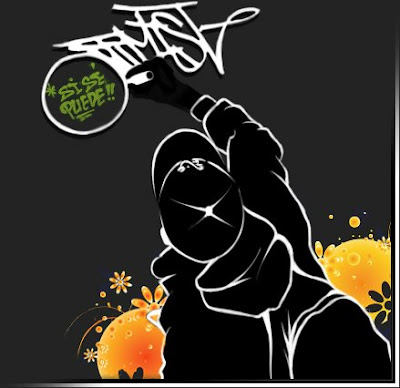
The question is often asked … "where did graffiti art start?"… The article below discusses the modern history of graffiti art from the 1960’s onwards … it’s an interesting read … once you’ve read it, be sure to check out our how to draw graffiti home page for lots more resources on everything graffiti related
Where Did Graffiti Begin?
This modern history of graffiti began in the 60s in the West Coast of America, primarily Philadelphia. Some call this era the ground work era and it was artists such as Top Cat who began the evolution. Soon the movement spread to New York with writers inspired by their brothers across the country, resulting in ‘attacks’ of graffiti on trains as a method of political protest instead of directly violent acts. The style during this formative period in the history of graffiti is hard to discern with bubble lettering and wildstyle both being utilized heavily by different artists. However, as the movement moved forward into the 70s - the so called pioneering era, the wildstyle of Tracy 168 began to symbolize the arts movement.
At the same time in the history of graffiti, we can see a major rise in the sheer number of tags being created by artists, with mass bombing and tagging becoming more active. The size of the works began to increase with artists preferring to move into safer areas such as train depots so that they could create more intricate works. This included groups such as TF5 painting entire cars with the ever more popular spray paint.
This was to be the high water mark though in the history of graffiti as an underground art movement for the late 70s saw little innovation in the movement, probably strongly effected by the increased countermeasures employed by the city of New York. What resulted was a change in direction, away from a purely artistic and political focus into a musical collaboration with hip-hop which is still seen today.
That isn’t to say that was the end of graffiti, what followed in the history of graffiti was a period of acceptance by the art world at large for their style, most recently with the prominence of artists such as Banksy. However, graffiti has never strayed too far from it’s roots, with the Berlin Wall showing it’s continued power in the 1980s as a symbol of revolution. The same is true in Palestine today, and hence the basic goals which were present at the start of the history of graffiti still exist today.
girl graffiti alphabet

Fafi, along with Miss Van, is one of the world’s most famous female graffiti artists. Read more about the girls graffiti art below:
Fafi’s Gorgeous Graffiti Girls!
Fafi was born and raised in Toulouse France - the home of another "graffiti girl", Miss Van. She has been on the art scene since 1994 when she first witnessed the graffiti street art on her hometown walls. Inspired by the scenes depicted, she started her work and hasn’t looked back since.
Fafi’s style is quite unique. Fafi tends to depict women in various forms. She identifies a particular stereotype and will render it to create a "Fafi Girl". She paints exaggerated stereotypes of women in a cute and "Fafi" way. Her style helped re-define the graffiti scene and open new doors with what the artwork could be.
After she drew the public eye upon her, she started to travel around the world. Europe, USA, Japan, Hong-Kong, all got "Fafi’ed". Her work would appear around the world in galleries and advertisements. The world was truly her canvas!
Sony became infatuated with the cute and iconic figures Fafi would create and hired her to design a six-character toy set for their Time Capsule video game set. This only furthered her career as she made the transition from two dimensional to three dimensional work. Other companies followed suit and she procured contracts from Collette, Coca-Cola, M.A.C cosmetics, Adidas and other companies for her figurines.
Fafi got a lot of press coverage as well during this time. She was featured in many prestigious magazines such as Vogue, Elle, XLR8R, and Yen. She then published a few books, Girls Rock (2003) and Love and Fafiness (2006). These prints are very successful and can be seen in libraries and museums to purchase.
You are interested in art and love with the picture? you can see and visit the website Graffiti alphabet to see this type of sharing pictures as art Graffiti Alphabet,3D Digital Arrow Graffiti Alphabet,3D Digital Graffiti Alphabet,Digital Graffiti Alphabet,Graffiti Sketches,Tag Graffiti Alphabet,Graffiti Art,Graffiti Murals,Graffiti,Graffiti Alphabet Letters,Alphabet Graffiti Arrow, 3D Graffiti, Graffiti Letters,Graffiti Fonts,Graffiti 3D Alphabet,the Alphabet in Bubble Letters,Printable Alphabet Stencils,Graffiti Letter Fonts,3D Graffiti Wallpaper, Graffiti Alphabet Stencils.
No comments:
Post a Comment